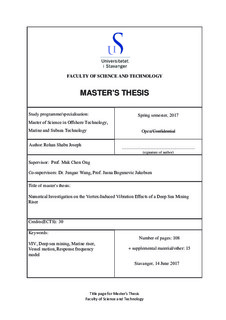| dc.contributor.author | Joseph, Rohan Shabu | |
| dc.date.accessioned | 2017-10-18T11:40:50Z | |
| dc.date.available | 2017-10-18T11:40:50Z | |
| dc.date.issued | 2017-06-14 | |
| dc.identifier.uri | http://hdl.handle.net/11250/2460808 | |
| dc.description | Master's thesis in Offshore technology: Marine and subsea technology | nb_NO |
| dc.description.abstract | In recent times, the deep sea mining industry has attracted growing attention globally as it targets mining activities in deeper waters of up to 6,000 m depth. Many of the technologies used in deep sea mining have been adopted from the offshore oil and gas industry. A self-propelled Seafloor Production Tool (SPT) is placed on the sea bottom and collects minerals from the seabed. These are then transported to the surface vessel through a Riser and Lifting System (RALS). The lift is achieved by either pneumatic or hydraulic means.
The major part of the RALS is the vertical riser that runs from the vessel and is connected to the SPT via a flexible hose, which decouples the relative motion between the riser and the SPT. Since the restriction by the flexible hose is relatively negligible, the bottom of the riser is free to move and large motions are expected under top vessel motion. As in the case of offshore oil and gas industry, the design, analysis and maintenance of the riser (major part of RALS) is one of the most challenging task.
One major issue for the marine riser is the vortex-induced vibrations (VIVs) caused by the shedding of vortices by the flow around the riser. The back and forth motion of the riser in the water due to the vessel motion can also generate an equivalent oscillatory flow which can cause VIV. The present work aims to study the VIV effects due to vessel motion on a deep sea mining riser. An empirical model is proposed to predict the VIV response of a riser under vessel motions of low Keulegan-Carpenter (KC) numbers with the vessel motion conditions under a fatigue sea-state. Numerical method validation was carried against model test results and full-scale measurement data. The results of the validation were used to fine tune the model for predicting the VIV response of an ultra-long mining riser under vessel motions. Since the vessel motion-induced VIV would cause similar stresses and fatigue damage as the current induced VIV, a fatigue damage analysis of the riser due to vessel motion induced VIV is also conducted. Further, VIV due to ocean current is also investigated and compared with the VIV due to vessel motions | nb_NO |
| dc.language.iso | eng | nb_NO |
| dc.publisher | University of Stavanger, Norway | nb_NO |
| dc.relation.ispartofseries | Masteroppgave/UIS-TN-IKM/2017; | |
| dc.subject | offshore teknologi | nb_NO |
| dc.subject | undervannsteknologi | nb_NO |
| dc.subject | VIV | nb_NO |
| dc.subject | response frequency model | nb_NO |
| dc.subject | deep sea mining | nb_NO |
| dc.title | Numerical Investigation on the Vortex-Induced Vibration Effects of a Deep Sea Mining Riser | nb_NO |
| dc.type | Master thesis | nb_NO |
| dc.subject.nsi | VDP::Teknologi: 500::Marin teknologi: 580::Offshoreteknologi: 581 | nb_NO |
